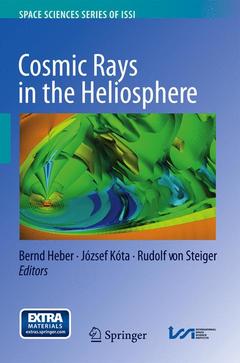Description
Cosmic Rays in the Heliosphere, Softcover reprint of the original 1st ed. 2014
Temporal and Spatial Variations
Space Sciences Series of ISSI Series, Vol. 43
Coordinators: Heber Bernd, Kóta József, Steiger Rudolf
Language: English
Subjects for Cosmic Rays in the Heliosphere:
Publication date: 08-2015
Support: Print on demand
Publication date: 08-2013
403 p. · 15.5x23.5 cm · Hardback
Description
/li>Contents
/li>Biography
/li>Comment
/li>
Presents a comprehensive synopsis of the current state of cosmic rays, their modulation and their effects in the Earth?s atmosphere.
Leading scientists in the field assess the current state of our understanding of the spatial and temporal variations of galactic and anomalous cosmic rays in the Heliosphere, and their relation to effects of the Sun. The main objective is to understand the spatial and temporal variation of galactic and anomalous cosmic rays in the light of recent observations, theory and modeling by identifying the key mechanism(s) of cosmic ray modulation and how changes on the Sun relate to changes in the observed characteristics of cosmic rays in the Heliosphere; examining the current long-lasting solar minimum and understand its implications for solar-cycle variations and long-term variations; and interpreting the long-term variations of cosmogenic radionuclides in terms of solar variability and climate change on Earth.
This volume is aimed at graduate students active in the fields of solar physics, space science, and cosmic ray physics.
Originally published in Space Science Reviews journal, Vol. 176/1-4, 2013.
Dr. Bernd Heber is a full professor (W2) at the Institute for Experimental and Applied Physics of the Christian-Albrechts-Universität of Kiel, Germany. He has expertise in cosmic ray transport, as well as in the analysis and interpretation of energetic particle data acquired by spacecraft (Helios, Ulysses, SOHO, STEREO, Pioneer, Voyager) instrumentation. He has investigated a broad range of problems relating to energetic particles in space, including solar and galactic cosmic ray propagation, shock processes, and the modulation of galactic cosmic rays as well as the cosmic ray interaction with the Earth atmosphere. His research interests also cover the development and optimization of new space instrumentation. He is the PI for energetic particle detectors on Ulysses, SOHO, and STEREO. He is and has been involved in the project studies for POEMS, Interstellar Probe, the Interstellar Heliopause Explorer, the Solar Orbiter and Juice mission.
Dr. József Kóta is Senior Research Scientist at the Lunar and Planetary Laboratory of the University of Arizona (Tucson, Arizona, USA). Previously he was at the Central Research Institute for Physics of the Hungarian Academy of Sciences. Dr. Kóta’s research interest is centered around energetic particles, solar wind, and magnetic fields in the Heliosphere. He conducts theoretical and numerical studies on galactic and anomalous cosmic rays, as well as fast neutral atoms (ENAs), which offer a unique tool to probe the remote areas of the heliosphere. He has developed a number of numerical codes to model the transport and acceleration of cosmic rays in the interplanetary magnetic field. He conducted theoretical research to understand the anisotropies of cosmic rays. He has been involved in modeling space weather in the Earth’s environment. The aim of his research is to understand, model, and forecast large solar energetic particle (SEP) events; to understand the mechanism how Coronal Mass Ejections drive a shockand accelerate




